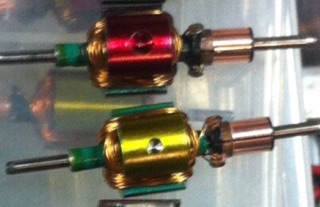Mario's explanation of static balancing is a good one. I have a different take on a couple of points though (*but any means of static balancing should be considered as really only "OK" for very mild winds).
You want to get a magnetic balancer for the best accuracy.
I dug in to this method some years ago, and was always able to get a better finished product using razor blades. The magnetic type balancers rely on a perfectly concentric point being ground on one end of the armature shaft, otherwise the armature is rotating on an axis that isn't the same as the armature's true center. It "seems" like this shouldn't matter much, but it can. On some armatures, you may wind up having to grind that point uncomfortably close to the coils or the com.
Also, these balancers use a pair of very strong neo magnets acting on the ends of the armature shaft. One end is floating, slightly away from the magnet, the pointed end is touching the opposite magnet. In order to suspend an armature in mid air, the pointed end of the arm is being pulled pretty hard against the face of the magnet, so the armature's ability to spin easily doesn't seem any better than when rolling along razor blades.
On the plus side, the magnetic type static balancers don't rely on having a perfectly clean and round shaft, while of course the razor blade type DOES. With the magnetic balancer, you should be able to balance even an arm with a splined shaft.
***If I were going to use the magnetic balancer, I would have a short shaft end adapter made with perfectly centered cone ground on it's end and a snug perfectly centered 2mm bore, made out of hardened steel. This would be no small thing, but it would at least help avoid more work and possible problems down the road.
There is one method I used that no one has come up with which is added balancing. The principal is to help you visualize where the actual weigh it coming (to remove) from when balancing.
I've done some of this, and documented it here somewhere back in my bazillion posts Mario.  Couple of thoughts:
Couple of thoughts:
1) You can definitely do balancing (*at least static balancing) by adding weight, rather than removing it by drilling or grinding. Just on general principle though, adding more rotating mass to an arm isn't ideal.
2) The steel and copper that make up almost all of an armature's mass are both dense/heavy materials. Whatever is being used to permanently add mass to the "light poles" of an arm (*as opposed to removing it from the heavy ones), must stay put under the great stresses exerted by a spinning arm...some sort of epoxy I suppose. Most any commercially available epoxy, even something like JB Weld with it's powdered iron content, is far less massive than steel or copper. That means you have to add a LOT of epoxy to make up for a little steel or copper. Maybe there's a more dense epoxy with something like powdered lead filler, but whatever you use has to be really tough.
***I also did some (*and still do occasionally) "prebalancing" on arms when I think it *might* be a good thing, by removing a small amount off the edges of the stack. I guess you could use additive balancing for this, and then the coils and final epoxy would help hold it in place. It would still take a lot of material being added, versus slightly removing some, and any added material would have to no be "in the way" of where you'd want to wind.


















